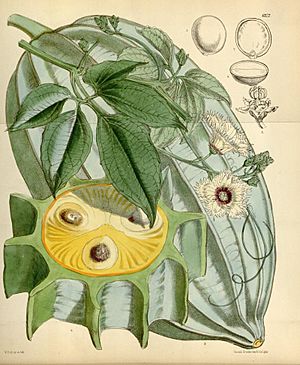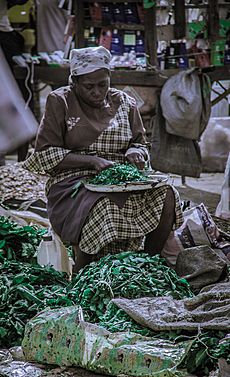Telfairia occidentalis facts for kids
Quick facts for kids Telfairia occidentalis |
|
|---|---|
 |
|
| Telfairia occidentalis, illustrated by Joseph Dalton Hooker, 1877 |
|
| Scientific classification | |
| Genus: |
Telfairia
|
| Species: |
occidentalis
|
Telfairia occidentalis is a tropical vine grown in West Africa. People grow it for its edible leaves and seeds. Some common names for this plant are fluted gourd and fluted pumpkin. In Nigeria, it's called ugu (in the Igbo language), okwukwo-wiri (in Ikwerre), and ikong-ubong (in Efik and Ibibio).
This plant belongs to the Cucurbitaceae family, which also includes pumpkins and cucumbers. It comes from southern Nigeria. The fluted gourd grows in many West African countries, but it's mostly farmed in southeastern Nigeria. People use it mainly in soups and traditional medicines. Even though the fruit itself isn't eaten, its seeds are full of protein and fat. This makes them a great addition to a healthy diet. The plant is a drought-tolerant type of perennial plant. This means it can handle dry weather and lives for many years. It's also dioecious, which means male and female flowers grow on separate plants. It's usually grown on a trellis or support.
About 30 to 35 million people in Nigeria traditionally use T. occidentalis. This includes groups like the Efik, Ibibio, Ikwerre, and Urhobo. However, the Igbo ethnic group uses it the most. They continue to grow it for food and traditional medicines. The fluted gourd is often mentioned in Igbo stories. It's believed to have healing powers and was used as a blood tonic for people who were weak or sick. It's native to southern Nigeria and was important in the Igbo people's international food trade.
Contents
What the Fluted Gourd Looks Like
The fluted gourd fruit can be quite big. Some studies show they can be from 16 to 105 centimeters long. On average, they are about 9 centimeters wide. Larger gourds can have many seeds, sometimes up to 196 seeds per fruit. These seeds are usually between 3.4 and 4.9 centimeters long.
The flowers of T. occidentalis grow in groups of five. They have creamy-white and dark red petals. When the fruit is young, it's light green, and it turns yellow when it's ripe. Most fluted gourds have separate male and female plants (dioecious). It's very rare to find plants with both male and female flowers on the same plant.
Healthy Nutrients in Fluted Gourd
The fluted gourd is known as an "oil seed" because it has a lot of oil, about 30%. The young shoots of the plant are rich in potassium and iron. The seeds are made up of about 27% protein and 53% fats. The leaves also have many antioxidants. These are good for protecting your liver and fighting germs.
The young shoots and leaves from the female plant are key ingredients in a Nigerian soup called ofe egwusi. The large, dark-red seeds (up to 5 cm) are full of fat and protein. You can eat them whole, grind them into a powder for soup, or make them into a fermented porridge.
How to Grow Fluted Gourd
T. occidentalis is usually grown vertically on structures like trellises. However, it can also be allowed to spread flat on the ground. Growing it flat helps to stop weeds from growing, especially when it's planted with a tall plant like maize.
The growing season starts in April or May when the seeds are planted. You can harvest the first leaves and shoots after about a month. After that, you can collect them every 2 to 4 weeks. Seeds are planted directly in the soil, usually in groups of three. This helps ensure that at least one seed will grow. The fruit is usually harvested between October and December. After harvesting, the seeds are collected and dried. Some seeds are eaten, and the rest are saved for planting next year.
The fluted gourd can grow new fruits from its roots for a long time, especially in well-drained soil. It grows from its seeds, which are protected by a hard outer shell. This plant can survive dry periods. Its roots can even stay alive for many years. It's a creeping plant that grows well if you give it bamboo sticks to climb on.
Storing Fluted Gourd
While the seeds of T. occidentalis store well, you need to be careful when storing other parts of the plant. The fruit pod itself spoils very quickly and can only be stored for up to 4 weeks. If the gourd is left whole and not stored or shipped correctly, it can get "pod rot." Even small cuts can lead to serious damage, making the fruit unusable.
You also need to be careful when storing the leaves. They can quickly lose their nutrients and water if not stored properly. To keep them fresh, store harvested leaves in sealed plastic bags. Keeping them at lower temperatures (2-4 °C) also helps.
Pests and Diseases
Pod rot is a big problem for people who buy and sell fluted gourd. This infection often happens during transport. However, it can also start before the plant is harvested. It begins as a small cut that lets germs get into the fruit.
Often, the infected area looks brown. This means it's likely contaminated by R. stolonifer or Erwina bacteria. But the infected area might also look black (from Aspergillis niger) or grey (from B. theobromae). Other signs of these germs include the pod tissue becoming soft and having a strong smell, or watery liquid inside the fruit. You can reduce pod rot by being careful not to damage the fruit during harvest and transport.
How People Use Fluted Gourd
The edible seeds can be boiled and eaten whole. They can also be fermented and added to a food called ogili. Traditionally, local tribes used the fluted gourd as a blood tonic. This was probably because of its high protein content. Flour made from the seeds can be used to make high-protein breads. Also, the shoots and leaves can be cooked and eaten as vegetables.
When T. occidentalis is prepared for traditional medicine, it's used to help with sudden attacks of seizures, malaria, and anemia. It also plays an important role in protecting against heart diseases.
See also
 In Spanish: Telfairia occidentalis para niños
In Spanish: Telfairia occidentalis para niños


